Mechanical Aptitude Tests are specialized tools designed to measure an individual’s understanding and application of mechanical concepts. These tests are crucial in industries such as engineering, the military, emergency services, and skilled trades, where mechanical comprehension is key. Here’s what you need to know:
- Purpose: These tests evaluate a candidate’s innate mechanical aptitude and their potential to succeed in roles that require mechanical reasoning. They assess understanding of machinery, knowledge of physical principles, spatial visualization, and problem-solving abilities.
- Format: Typically, these tests are timed, multiple-choice assessments with 20 to 50 questions. The questions are challenging but fair, and they do not require specific technical knowledge.
- Validity: Studies have shown a strong correlation between high scores on these tests and success in mechanical and technical positions. They are considered a fair and objective tool for screening candidates.
- Variety: There are several different mechanical aptitude tests, including the Wiesen Test of Mechanical Aptitude and the Ramsay Mechanical Aptitude Test, among others.
Remember, the specific format and content of the test can vary depending on the test provider and the specific job role. Therefore, it’s essential to familiarize yourself with the details provided by your test administrator or potential employer.
Did you know?
Mechanical Aptitude Tests typically include eight different question types: (1) forces, (2) levers, (3) pulleys, (4) gears, (5) springs, (6) simple electrical circuits, (7) hydraulics, and (8) tools. To progress in the hiring process, you’ll need to score 80% or higher. To achieve this, you’ll need to demonstrate mechanical comprehension, understand the workings of simple machines, and be familiar with basic physical forces.
Question Types Explained
Mechanical aptitude tests are generally timed multiple-choice tests. While each test is different, you can expect to have between 30-60 seconds per question. A Mechanical Aptitude Test is a multifaceted assessment tool, designed to measure your understanding and application of various mechanical concepts. The test is typically divided into several sections, each focusing on a different aspect of mechanical reasoning.
From basic physical forces to the use of common tools, these sections collectively provide a comprehensive evaluation of your mechanical aptitude. Understanding the types of questions you’ll encounter is the first step towards effective preparation. In this section, we’ll delve into the eight common question types found in a typical Mechanical Aptitude Test, explaining what each type assesses and the skills necessary to excel in each. Let’s explore these question types in more detail.
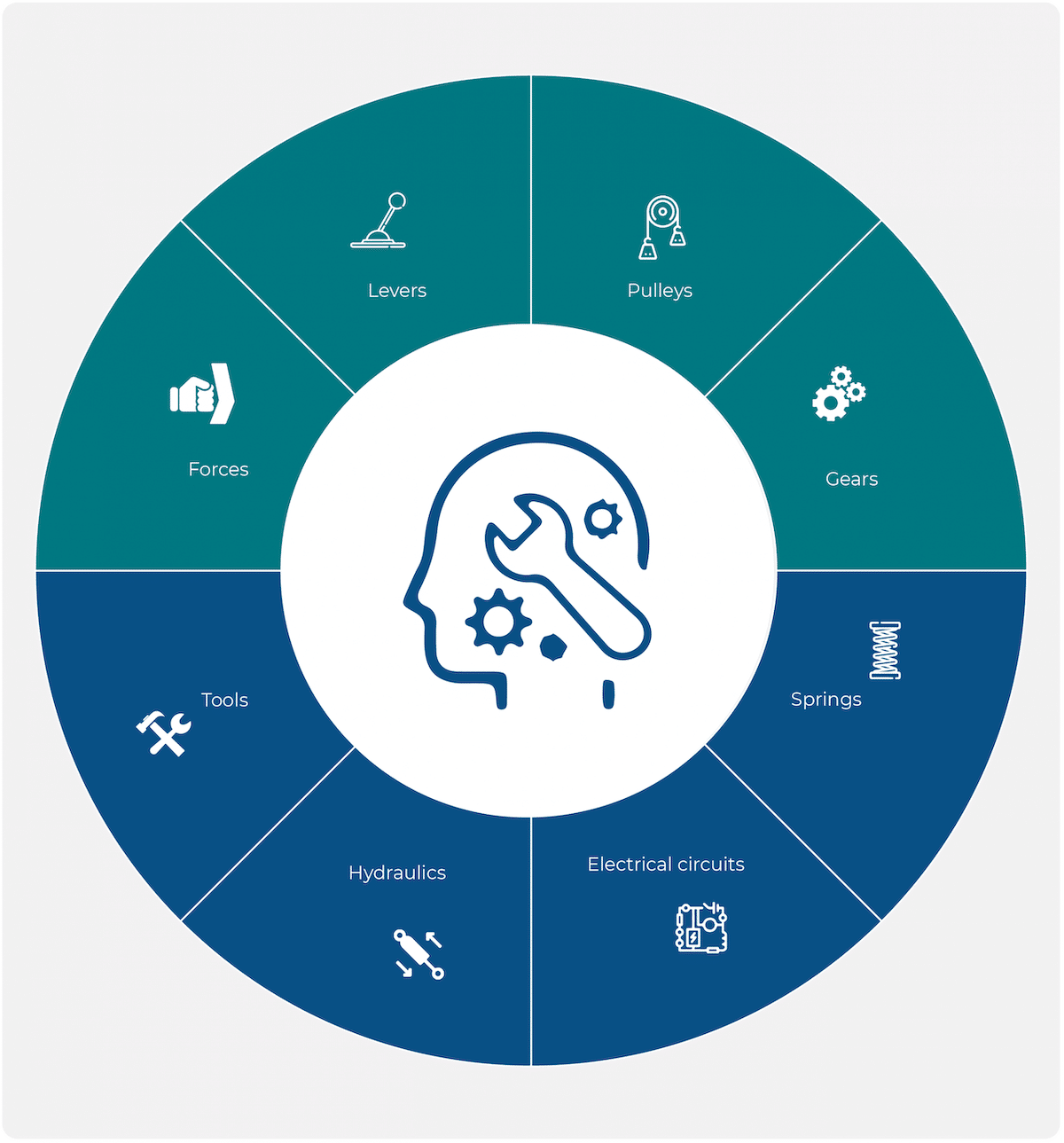
Basic Physical Forces
These questions test your understanding of fundamental physical principles such as gravity, friction, velocity, and heat. You might be asked to predict the trajectory of an object when certain forces are applied, or to identify the forces at work in a given scenario. To excel in this section, you need a good grasp of basic physics and the ability to apply these principles to real-world situations.
Basic Physical Forces Sample Question

Which weight will reach the ground first, if weight B is heavier than weight A?
(If at the same time, mark C.)
- A.
- B.
- C.
The correct answer is C – at the same time.
It can be seen that weight B is heavier than weight A, i.e. WB > WA. Now, weight is defined by Newton’s 2nd Law as:
Weight (W) = mass(m) * gravitational acceleration (g)
But for Earth, the gravitational acceleration is a constant i.e. 9.81m/s2. This shows that neglecting the effect of air resistance, the weight of a body does not change its downward acceleration due to gravity.
Even though weight A and B are different, according to Newton’s law, it does not change their accelerations towards the earth. This means that they will reach the ground at the same time.
Levers
This section presents diagrams of levers with weights placed at various points. You might be asked to calculate the force needed to balance the lever, or to predict the movement of the lever when a weight is added or removed. Success in this section requires an understanding of the principles of balance and equilibrium, as well as the ability to perform basic mathematical calculations.
Levers Sample Question
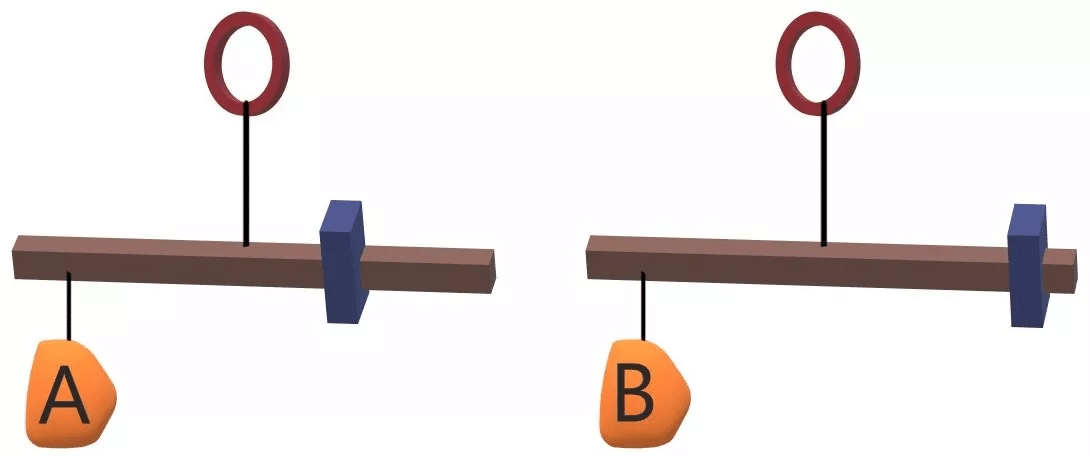
Two fixation points provide an accurate force to prevent the weights from breaking the poles. Which weight is heavier?
(If equal, mark C.)
- A.
- B.
- C.
The correct answer is B.
The given problem can be modeled as a beam balance with point O as the pivot. Summation of moments on O is zero since no rotation occurs. We denote the weights of load and counterweight as FL and FW and their moment arms as RL and RW respectively. Now, ΣM=0,
FW × RW – FL × RL = 0 or FL = RW/RL × FW
Since FW and RL are the same in both cases, and RW for B is greater than RW for A, hence load B must be heavier.
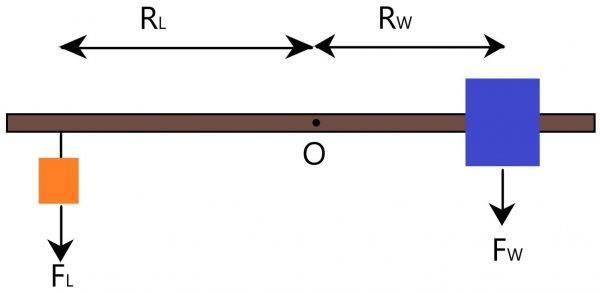
Pulleys
Questions in this section involve pulley systems. You might be asked to determine the force required to lift a weight using the pulley, or to identify the mechanical advantage of a given pulley system. To do well here, you need to understand how pulleys work and how they can make tasks easier by changing the direction of the force or multiplying the force applied.
Pulleys Sample Question
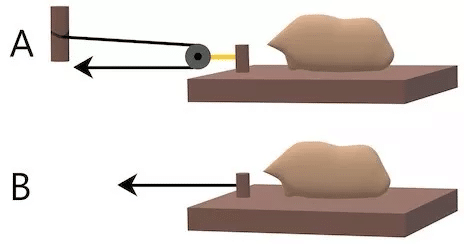
A stone is dragged in two different ways. In which method is it easier to drag the stone?
(If equal, mark C.)
- A.
- B.
- C.
The correct answer is A.
When the stone is pulled directly, the applied force (FB) is directly equal to the tension in the string. When a pulley is used, the tension is divided into two and the applied force (FB) is halved. This can be mathematically stated as:
FB = TB = FFriction and FA = TA = 0.5TB = 0.5FFriction
As shown in the figure below, the force resisting the movement is the friction force (FFriction). The pulley helps in dividing the required force into two parts and hence facilitates the process. Hence method A is easier for dragging the stone.
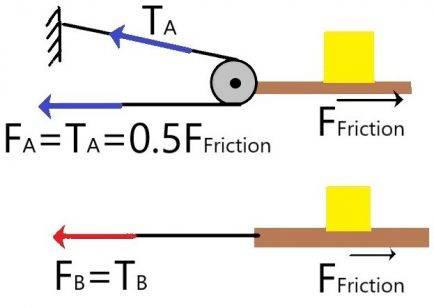
Gears
These questions involve diagrams of gear systems. You might be asked to determine the direction in which a gear will turn, or to calculate the speed of a gear based on the speeds of other gears in the system. This section requires an understanding of how gears interact with each other, as well as the ability to visualize the movement of interconnected parts.
Gears Sample Question
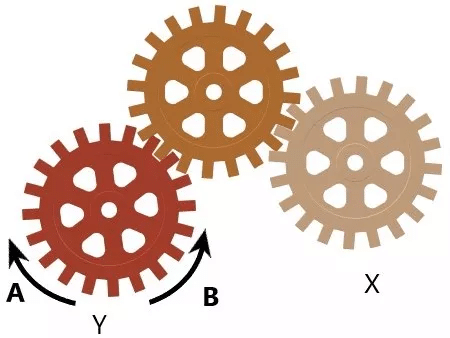
Three cogwheels mesh in a gear train. In which direction should gear Y rotate to have gear X rotate counterclockwise?
(If it cannot be determined, mark C.)
- A.
- B.
- C.
The correct answer is B.
As we know that the tangential velocity of two meshed gears always remains the same. However, their direction of rotation is always the opposite of each other. We can see that gear X meshes with another gear. We will call it the idler-gear. Gear Y meshes with the idler-gear as well.
In order to rotate the gear X counterclockwise, the idler-gear needs to be rotated clockwise. But since the idler-gear meshes with gear Y, it can only rotate if gear Y rotates counterclockwise. Hence gear Y should be rotated in direction B.
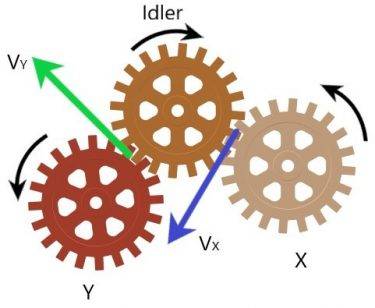
Springs
In this section, you’ll be presented with questions involving springs. You might be asked to calculate the force exerted by a compressed or stretched spring, or to predict the movement of a spring when a force is applied. To excel in this section, you need to understand Hooke’s law, which states that the force a spring exerts is proportional to its extension or compression.
Springs Sample Question
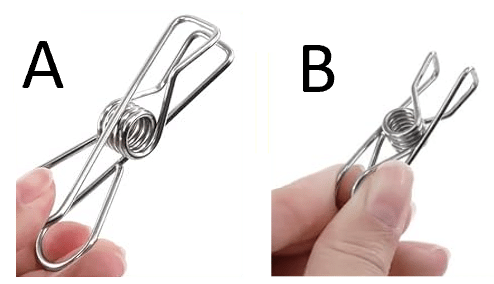
At which position of the torsion spring is the potential energy greater?
(If equal, mark C.)
- A.
- B.
- C.
The correct answer is B.
A torsional spring is an energy-storing element, which stores potential energy in the form of strain. Initially, the spring is at the normal extension, as shown by position A. When compressed, it compresses to position B. At this point, it has stored potential energy, which means that it will tend to regain its original position once the applied force is removed. Since the work done on the spring equals its change in potential energy, the potential energy of the spring increases when it is compressed from position A to position B after the work is done. Hence the potential energy of the torsional spring is greater at position B.
Simple Electrical Circuits
These questions test your understanding of basic electrical principles. You might be asked to identify the path of an electrical current, to determine the effect of a switch opening or closing, or to calculate the voltage or current in a simple circuit. Success in this section requires a basic understanding of electrical circuits, including concepts such as voltage, current, resistance, and the function of switches and loads.
Simple Electrical Circuits Sample Question
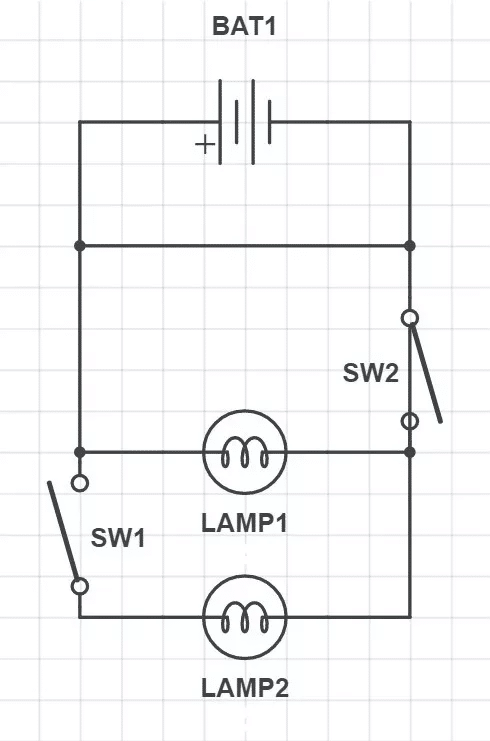
In the current structure, switch 1 is on and switch 2 is off. Which lamp will light up?
- Lamp 1
- Lamp 2
- Both/neither
The correct answer is C – neither.
It can be seen from the structure that the given circuit is short-circuited by a jumper wire connecting the two terminals, highlighted in the figure below. A short circuit occurs when two nodes having a finite potential difference are connected to each other without having any resistance between them.
According to Ohms’ Law: Current (I) = Potential Difference (V) / Resistance (R)
If resistance is near zero, then the amount of current flow will be very large. Since current always takes the path of least resistance, it will move through the jumper wire and will not pass through the bulbs. In this case, we do not need to consider the configuration of the switches.
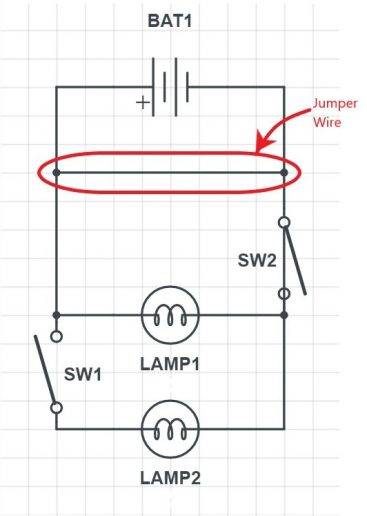
Hydraulics
This section involves questions about the mechanical properties and uses of liquids. You might be asked to calculate the pressure exerted by a liquid in a container, or to predict the movement of a hydraulic system when a force is applied. To do well here, you need to understand Pascal’s law, which states that a change in pressure at any point in an enclosed fluid is transmitted equally throughout the fluid.
Hydraulics Sample Question
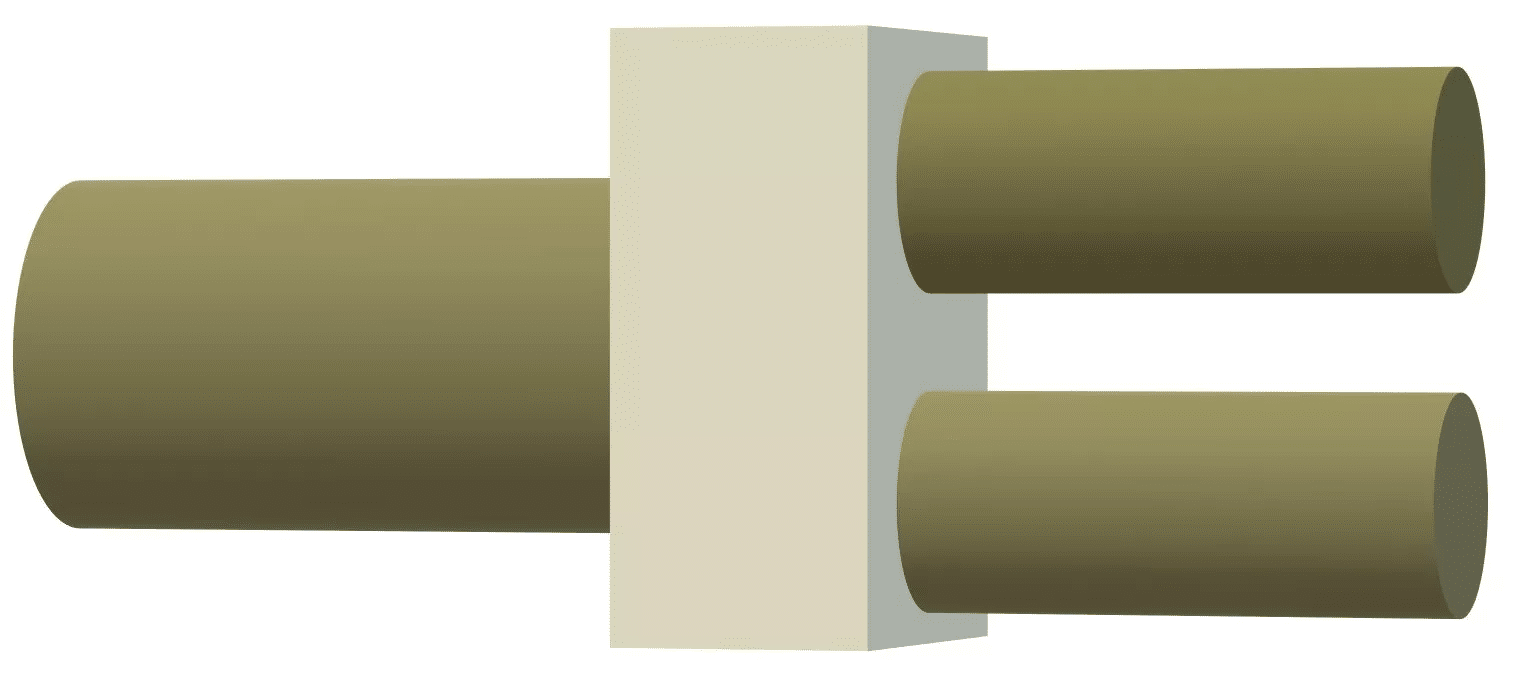
Water flows through the big pipe on the left and there is no air in the system. The cross-section area of each of the smaller pipe is exactly half that of the big pipe. What will be the velocity of the water flow in the smaller pipes?
- Greater than that of the big pipe
- Equal to that of the big pipe
- Less than that of the big pipe
The correct answer is B.
Since water is incompressible, we can safely assume that the density of water does not change from entering to leaving the system. Thus, we can conclude that the mass of water entering the big pipe will be equal to that leaving the smaller pipes i.e.:
Mass flow into the pipe (Δm1) = Mass flow out of the pipes (Δm2)
It is given that the cross-section area of each of the smaller pipe is exactly half that of the big pipe. This means that the cross-section area of both of the smaller pipes is equal to that of the big pipe.
In cases that the overall exit area is smaller than the entry area, the flow velocity in the exit area will be greater to compensate for this difference and balance the equation.
However, in our cases, there is no difference between the entry area and the exit area, therefore, no change in velocity is required to balance the equation.
Tools
In this section, you’ll be presented with images of various tools and asked to identify them and their uses. This section tests your familiarity with common tools and your understanding of their applications in mechanical tasks.
Tools Sample Question
What is this tool used for?
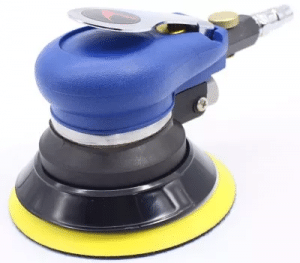
The correct answer is A.
This power tool is a sander.
The table below provides a succinct overview of the different types of questions typically found in a Mechanical Aptitude Test. It outlines the key skills assessed by each question type and the knowledge required to perform well. This summary will serve as a quick reference guide during your test preparation.
| Question Type | Skills Assessed | Knowledge Required |
|---|---|---|
| Basic Physical Forces | Understanding of fundamental physical principles | Basic physics, application of principles to real-world situations |
| Levers | Understanding of balance and equilibrium | Principles of balance, basic mathematical calculations |
| Pulleys | Understanding of pulley systems | How pulleys work, force direction and multiplication |
| Gears | Understanding of gear systems | Interaction of gears, visualization of interconnected parts |
| Springs | Understanding of spring dynamics | Hooke’s law, force calculation |
| Simple Electrical Circuits | Understanding of basic electrical principles | Electrical circuits, voltage, current, resistance |
| Hydraulics | Understanding of fluid mechanics | Pascal’s law, pressure calculation |
| Tools | Identification and application of common tools | Familiarity with common tools and their uses |
To perform well on a Mechanical Aptitude Test, you’ll need a solid understanding of basic mechanical and physical principles, good spatial reasoning skills, and the ability to apply these principles to solve problems. Familiarity with common tools and their uses is also important. Remember, these tests are designed to assess your innate mechanical aptitude rather than your learned knowledge, so focus on understanding concepts rather than memorizing facts.
Preparation Strategies
Preparing for a Mechanical Aptitude Test can seem daunting, but with the right strategies, you can approach the test with confidence. The key to success lies not only in understanding the mechanical concepts but also in honing your problem-solving skills and test-taking strategies. Here are some proven strategies to help you prepare effectively:
- Understand the Test Format: Familiarize yourself with the test format and types of questions you’ll encounter. Knowing what to expect can help reduce anxiety and improve your performance on the test day.
- Review Basic Mechanical and Physical Principles: Brush up on basic mechanical concepts such as forces, levers, pulleys, gears, springs, simple electrical circuits, hydraulics, and tools. Understanding these principles is crucial to answering the test questions correctly.
- Practice Spatial Reasoning: Many questions on the test require good spatial reasoning skills. Practice visualizing the movement of mechanical parts and the effects of physical forces on objects.
- Solve Practice Questions: The best way to prepare for the test is by solving practice questions. This will help you become familiar with the types of questions on the test and improve your problem-solving speed.
- Work on Your Timing: Mechanical Aptitude Tests are usually timed, so it’s important to work on your speed as well as your accuracy. Practice answering questions quickly and accurately.
- Review Basic Mathematics: Some questions on the test may require basic mathematical calculations. Make sure you’re comfortable with basic arithmetic, fractions, and percentages.
- Stay Physically and Mentally Fit: Regular exercise and a healthy diet can improve your cognitive function and concentration. Make sure you’re in good physical and mental shape before the test.
- Get a Good Night’s Sleep: Make sure to get a good night’s sleep before the test. Being well-rested can significantly improve your concentration and performance.
Remember, the key to success on a Mechanical Aptitude Test is understanding the underlying concepts and applying them effectively. While it’s important to prepare thoroughly, it’s equally important to approach the test with confidence. Believe in your abilities and give it your best shot.
“The mechanical aptitude test was definitely the most challenging part of the interview process. There were a lot of questions about how different mechanical devices work, and I had to really think about how the different parts would interact with each other. I think the most important thing is to have a basic understanding of how things work, and then to be able to apply that knowledge to solve problems. If you can do that, you should be able to do well on the test.”
Source: u/Electrical_Engineer, Reddit
Test Features
Purpose of the Test
The primary purpose of a Mechanical Aptitude Test is to assess an individual’s ability to understand and apply mechanical concepts and principles. These tests are used to evaluate a candidate’s potential to succeed in roles that require mechanical reasoning and problem-solving skills.
Format of the Test
A typical Mechanical Aptitude Test is a timed, multiple-choice assessment. The questions are presented in a written and diagrammatic format, and the test usually consists of 20 to 50 questions. The time limit can range from 15 to 30 minutes, depending on the test provider.
Types of Questions
The test includes a variety of question types, each assessing a different aspect of mechanical aptitude. These may include questions on basic physical forces, levers, pulleys, gears, springs, simple electrical circuits, hydraulics, and tools.
Scoring System
The scoring system of a Mechanical Aptitude Test is often comparative. This means that your score is determined not only by the number of questions you answer correctly, but also by how your performance compares to that of other test-takers.
Test Administration
Mechanical Aptitude Tests are usually administered online, but can also be paper-based. They are often used as part of the recruitment process for jobs that require mechanical comprehension and problem-solving skills.
Use by Employers
Employers use the results of Mechanical Aptitude Tests to identify candidates with a natural mechanical aptitude. High scores on these tests are often correlated with success in mechanically oriented roles.
“I was really nervous about the mechanical aptitude test, but it turned out to be not as bad as I thought it would be. There were a few questions that were tricky, but overall I thought it was fair. I think the most important thing is to stay calm and take your time. If you rush through the test, you’re more likely to make mistakes. Just take your time, read the questions carefully, and you should be fine.”
u/Sheetmetal_Worker, Reddit
Technical Facts
Fast Facts (tl;dr)
- Multiple-choice format
- Timed, typically 15-30 minutes
- Contains 20-50 questions
- Assesses mechanical concepts and principles
- Often administered online
- Used in recruitment for mechanical roles
- Scoring is comparative, based on correct answers and performance relative to others
- Does not require specific technical knowledge
- Available in multiple languages
- Periodically updated to reflect industry standards
Test Difficulty
The difficulty level of a Mechanical Aptitude Test can vary depending on the specific test and the test-taker’s familiarity with the concepts being assessed. However, these tests are generally considered challenging due to their focus on mechanical principles and problem-solving skills.
Test Validity
Mechanical Aptitude Tests are designed to be valid and reliable measures of a candidate’s mechanical aptitude. They are developed based on rigorous psychometric standards to ensure that they accurately and consistently measure the skills they are intended to assess.
Test Variations
While most Mechanical Aptitude Tests assess similar skills, there can be variations between different tests. For example, some tests may place more emphasis on certain types of questions or concepts than others. It’s important for test-takers to familiarize themselves with the specific test they will be taking.
Test Accessibility
Most Mechanical Aptitude Tests are designed to be accessible to a wide range of test-takers. They typically do not require any specific technical knowledge or experience, and the questions are usually based on everyday mechanical scenarios.
Test Languages
Mechanical Aptitude Tests are typically available in multiple languages to accommodate test-takers from different linguistic backgrounds. However, the specific languages available can vary depending on the test provider.
Test Updates
Mechanical Aptitude Tests are periodically updated to ensure that they continue to accurately measure mechanical aptitude in the context of current industry standards and practices. Test-takers should ensure that they are preparing for the test using the most up-to-date materials.
Top Mechanical Aptitude Tests in the Market
When preparing for a Mechanical Aptitude Test, it’s beneficial to familiarize yourself with the top tests in the market. These tests are widely recognized and used by employers across various industries. Understanding the structure and focus of these tests can help you prepare more effectively. Here, we provide a detailed description of the top Mechanical Aptitude Tests available today, along with my personal insights on each.
SHL Verify Mechanical Comprehension Test
The SHL Verify Mechanical Comprehension Test is a popular choice among employers. It assesses an individual’s understanding of basic mechanical principles, including forces, motion, and the relationship between them. The test consists of multiple-choice questions based on diagrams of various mechanical scenarios. It’s designed to measure a candidate’s ability to understand and apply mechanical concepts without requiring any specific technical knowledge. In my opinion, this test is quite comprehensive but can be challenging due to its focus on diagrammatic questions. However, its popularity among employers makes it a crucial one to prepare for.
Bennett Test of Mechanical Comprehension (BMCT)
The Bennett Test of Mechanical Comprehension (BMCT) is a widely used mechanical aptitude test. It measures a candidate’s ability to perceive and understand the relationship of physical forces and mechanical elements in practical situations. The BMCT is particularly popular in fields that require the operation, maintenance, and repair of machinery and equipment. While the BMCT is known for its practical relevance, it can be challenging for those not familiar with machinery and equipment. However, its wide usage makes it a valuable test to conquer.
Wiesen Test of Mechanical Aptitude
The Wiesen Test of Mechanical Aptitude (WTMA) is designed to measure an individual’s mechanical aptitude, or ability to learn to use and maintain equipment and machinery. It’s used primarily in industrial and technical jobs. The WTMA is relatively straightforward, making it less intimidating for test-takers. However, its focus on equipment and machinery might be challenging for those without prior exposure to such environments.
Barron’s Test of Mechanical Aptitude
Barron’s Test of Mechanical Aptitude measures a candidate’s understanding of basic mechanical principles and their ability to apply this knowledge to solve problems. The test is known for its rigorous and comprehensive assessment of mechanical aptitude, making it one of the more challenging tests. However, its thoroughness can provide a well-rounded evaluation of a candidate’s mechanical aptitude.
Stenquist Test of Mechanical Aptitude
The Stenquist Test of Mechanical Aptitude is a classic test that assesses mechanical understanding and spatial visualization. It’s a visual test, with questions based on pictures of various mechanical scenarios. The Stenquist Test is particularly useful in fields where spatial visualization is important, such as engineering and technical design. While the visual nature of the test can be engaging, it can also be challenging for those who struggle with spatial reasoning.
Ramsay Mechanical Aptitude Test (MAT)
The Ramsay Mechanical Aptitude Test (MAT) is a short, multiple-choice test that measures the ability to learn the skills required for various mechanical, maintenance, and production occupations. The MAT is used by many companies for selection and placement of industrial and manufacturing jobs. Its brevity makes it less daunting for test-takers, but its focus on practical skills can be challenging for those without prior experience in mechanical roles.
Overview of Top Mechanical Aptitude Tests
This table provides a concise summary of the top Mechanical Aptitude Tests in the market. It outlines the key features of each test, along with my personal insights on their difficulty level, popularity, and unique aspects. This summary will serve as a quick reference guide during your test preparation.
| Test | Key Features | Personal Insights | Duration | Number of Questions |
|---|---|---|---|---|
| SHL Verify Mechanical Comprehension Test | Assesses understanding of basic mechanical principles, multiple-choice, diagrammatic questions | Comprehensive but challenging due to diagrammatic focus, very popular among employers | 15 minutes | 18 questions |
| Bennett Test of Mechanical Comprehension (BMCT) | Measures understanding of physical forces and mechanical elements in practical situations | Practical and relevant, can be challenging for those unfamiliar with machinery, widely used | 25 minutes | 55 questions |
| Wiesen Test of Mechanical Aptitude (WTMA) | Measures ability to learn to use and maintain equipment and machinery | Straightforward but requires familiarity with equipment and machinery | 30 minutes | 60 questions |
| Barron’s Test of Mechanical Aptitude | Measures understanding of basic mechanical principles and problem-solving ability | Rigorous and comprehensive, one of the more challenging tests | 30 minutes | 60 questions |
| Stenquist Test of Mechanical Aptitude | Assesses mechanical understanding and spatial visualization, visual test | Engaging but can be challenging for those who struggle with spatial reasoning | 2×45 minutes | 2×95 questions |
| Ramsay Mechanical Aptitude Test (MAT) | Short, multiple-choice test that measures ability to learn skills required for mechanical occupations | Less daunting due to its brevity, but requires practical skills | 20 minutes | 36 questions |
Results Scale and Interpretations
Understanding the scoring and interpretation of Mechanical Aptitude Test results is crucial for both test-takers and employers. The score report provides a comprehensive overview of a candidate’s mechanical aptitude and can be used to assess their suitability for roles that require these skills.
The score report of a Mechanical Aptitude Test typically includes the following components:
- Raw Score: This is the total number of questions that the test-taker answered correctly. It provides a straightforward measure of the test-taker’s performance.
- Percentile Ranking: This compares the test-taker’s performance to that of a norm group. For example, a percentile ranking of 70 means the test-taker performed better than 70% of the norm group.
- Sub-scores: Some tests provide sub-scores for different sections or types of questions. These can provide a more detailed view of the test-taker’s strengths and weaknesses.
- Score Range: This indicates the minimum and maximum possible scores on the test. The test-taker’s score can be compared to these ranges to assess their performance.
For instance, in the Ramsay Mechanical Aptitude Test (MAT), the test is scored based on the total number of correct answers, which is referred to as the raw score. This raw score is then compared to the performance of a norm group to determine the test-taker’s percentile ranking. The Ramsay MAT also provides T-Score equivalents for raw scores. The T-Score is a type of standardized score that adjusts the raw score based on the mean and standard deviation of the scores of the norm group.
For example, if a test-taker named John, who is 12 years old, gets a total of 26 questions right in Test I, his raw score is 26. By referring to the T-Score equivalents, we can see that a raw score of 26 is equivalent to a T-Score of 40. This means that John’s score is exactly at the -1 standard deviation position on the T-Scale. If we refer to the percentile ranks for the age of 12, we can see that a T-Score of 40 is equivalent to the 17th percentile rank. This means that John performed better than 17% of the 12-year-olds who took the test.
In conclusion, the score report of a Mechanical Aptitude Test provides a comprehensive overview of a candidate’s mechanical aptitude. By understanding the different components of the score report, test-takers can gain a better understanding of their performance, and employers can make more informed decisions about a candidate’s suitability for a role. For the most accurate information, I recommend checking the official test provider’s website or contacting them directly.
Mechanical Aptitude Test Scoring
This table provides a concise summary of the key components of a Mechanical Aptitude Test score report and how they are interpreted. This summary will serve as a quick reference guide for understanding your test results.
| Component | Description | Example |
|---|---|---|
| Raw Score | Total number of questions answered correctly | If a test-taker answers 26 questions correctly, their raw score is 26 |
| Percentile Ranking | Compares the test-taker’s performance to that of a norm group | A percentile ranking of 70 means the test-taker performed better than 70% of the norm group |
| Sub-scores | Scores for different sections or types of questions | Some tests provide sub-scores to highlight strengths and weaknesses |
| Score Range | Indicates the minimum and maximum possible scores | The test-taker’s score can be compared to these ranges to assess their performance |
| T-Score (Ramsay MAT) | Standardized score that adjusts the raw score based on the mean and standard deviation of the norm group | A raw score of 26 is equivalent to a T-Score of 40, indicating performance at the -1 standard deviation position on the T-Scale |
While every company determines its own passing scores, the different tests provide percentile ranges for different positions. For example, Criteria Corp’s Wiesen test report shows recommended scores by position.
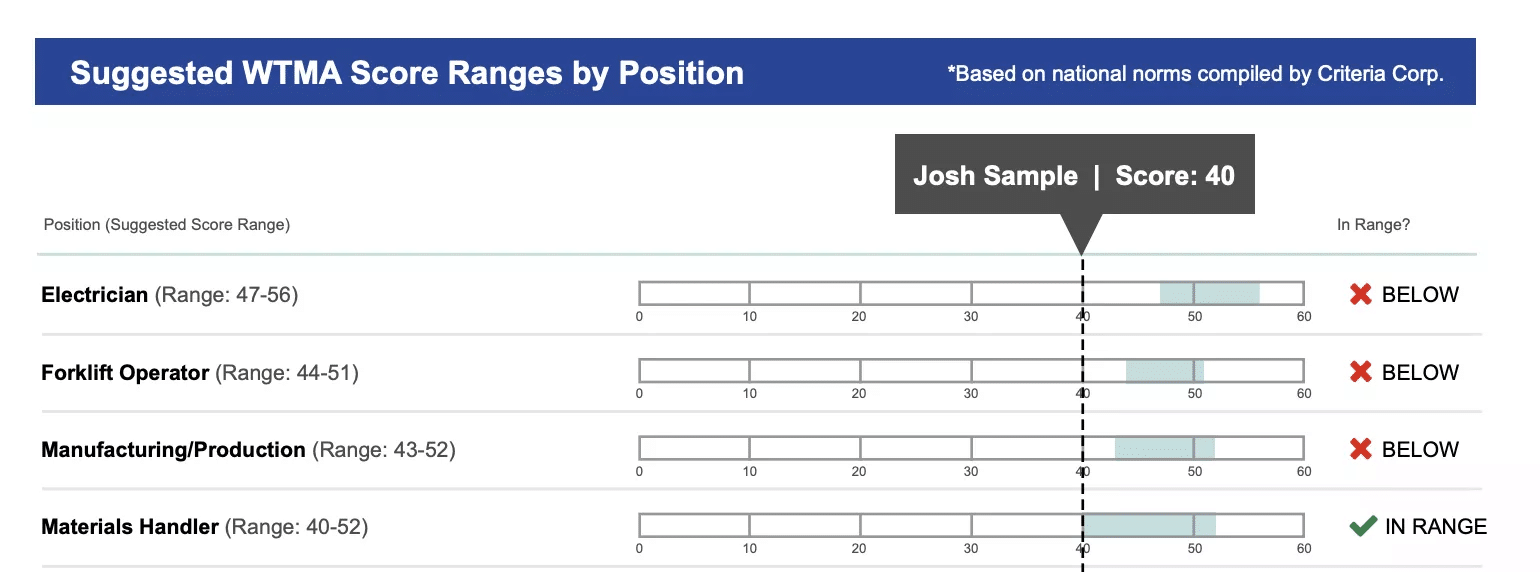
One rule of thumb to keep in mind is that employers are looking for candidates who score a minimum of 70%-80% regardless of which mechanical aptitude test is being taken. If you’re serious about a job in a mechanical job, you’ll need to score well to get your foot in the door.
iPREP: Concise. Focused. What you need.
Sign up
Immediate access
Practice
Online self-paced
Pass
Ace that Test!
Mechanical Aptitude Test FAQs
A Mechanical Aptitude Test is a type of assessment used to measure an individual’s understanding and application of mechanical concepts and principles. These tests are often used in the recruitment process for roles that require mechanical reasoning and problem-solving skills.
These tests measure a candidate’s ability to understand and apply mechanical concepts and principles. This includes understanding of forces, levers, pulleys, gears, springs, simple electrical circuits, hydraulics, and tools.
A typical Mechanical Aptitude Test is a timed, multiple-choice assessment. The questions are presented in a written and diagrammatic format, and the test usually consists of 20 to 50 questions.
The scoring system of a Mechanical Aptitude Test is often comparative. This means that your score is determined not only by the number of questions you answer correctly, but also by how your performance compares to that of other test-takers.
Employers use the results of Mechanical Aptitude Tests to identify candidates with a natural mechanical aptitude. High scores on these tests are often correlated with success in mechanically oriented roles.
No, Mechanical Aptitude Tests typically do not require any specific technical knowledge or experience. The questions are usually based on everyday mechanical scenarios.
Yes, preparation for a Mechanical Aptitude Test typically involves studying the basic principles of mechanics and practicing with sample questions or practice tests. Understanding the concepts and becoming familiar with the types of questions asked can significantly improve a test-taker’s performance.
Yes, most Mechanical Aptitude Tests are available in multiple languages to accommodate test-takers from different linguistic backgrounds. However, the specific languages available can vary depending on the test provider.
Yes, Mechanical Aptitude Tests are periodically updated to ensure that they continue to accurately measure mechanical aptitude in the context of current industry standards and practices.
Mechanical Aptitude Tests are usually administered online, but can also be paper-based. They are often used as part of the recruitment process for jobs that require mechanical comprehension and problem-solving skills.
Mechanical Aptitude Test Tips
- Arrive Early: Make sure to arrive at the test center early. This will give you time to settle in, relax, and mentally prepare for the test. Rushing can increase anxiety and negatively impact your performance.
- Bring Necessary Materials: Check beforehand what materials you need to bring to the test. This could include identification, a calculator, or other items. Being prepared will help you avoid unnecessary stress on the day of the test.
- Read Instructions Carefully: Before you start the test, read all the instructions carefully. Make sure you understand the format of the test, how to mark your answers, and whether there’s a penalty for incorrect answers.
- Manage Your Time: Keep an eye on the time. Mechanical Aptitude Tests are timed, and it’s important to pace yourself so you have a chance to answer all the questions.
- Analyze Diagrams: Many questions on Mechanical Aptitude Tests include diagrams. Take the time to analyze these carefully, as they often contain crucial information for answering the question.
- Trust Your Instincts: If you’re unsure about a question, trust your instincts. Your first response is often the correct one. Don’t waste too much time second-guessing yourself.
- Stay Calm: Finally, stay calm throughout the test. It’s natural to feel some anxiety, but try to keep it under control. Take deep breaths, stay focused, and remember that it’s just a test. Your attitude can have a big impact on your performance.
“The mechanical aptitude test was a bit of a mind-bender. There were a few questions that I had to really think about, but I eventually figured them out. I think the most important thing is to be able to visualize how things work. If you can see in your mind how a mechanical device would work, you’ll be able to answer the questions much more easily. Just don’t get too stressed out, and take your time.”
u/Mechanical_Designer, Reddit
Administration
- Test Location: Mechanical Aptitude Tests are typically administered online, but can also be taken at a physical test center, depending on the test provider.
- Test Schedule: The test schedule can vary. For online tests, you may be able to choose your own test date and time. For tests at a physical location, the test provider will usually set the schedule.
- Test Format: These tests are usually computerized and follow a multiple-choice format. Each question presents a mechanical scenario, often accompanied by a diagram, and you must choose the best answer from the given options.
- Test Materials: For computerized tests, you typically won’t need to bring any materials. For paper-based tests, you may need to bring a pencil and eraser. Always check the test instructions beforehand to see if you need to bring any specific materials.
- Cost: The cost of a Mechanical Aptitude Test can vary depending on the test provider. Some employers may cover the cost of the test as part of the recruitment process.
- Retake Policy: The retake policy can also vary. Some test providers may allow you to retake the test after a certain period of time, while others may limit the number of retakes. Check the test provider’s policy for specific details.
Test Provider
Bennett Mechanical Comprehension Test (BMCT): The BMCT is provided by Pearson, a leading global learning company. Established in 1844, Pearson provides a range of educational products and services to institutions, governments, and individual learners. The BMCT is one of their top products, used worldwide to assess candidates’ mechanical aptitude and spatial recognition.
SHL Verify Mechanical Comprehension Test: SHL, a global leader in talent solutions, provides the SHL Verify Mechanical Comprehension Test. Founded in 1977, SHL offers a comprehensive suite of talent assessment and development solutions. Their Mechanical Comprehension Test is used globally by organizations to assess candidates for roles that require mechanical reasoning.
Wiesen Test of Mechanical Aptitude (WTMA): The WTMA is provided by Criteria Corp, a leading provider of pre-employment testing services. Founded in 2006, Criteria Corp offers a wide range of aptitude, personality, and skills tests, including the WTMA, which is used to assess mechanical aptitude in job applicants.
Ramsay Mechanical Aptitude Test (MAT): The Ramsay MAT is provided by Ramsay Corporation, a technology-driven provider of testing and consulting services. Established in 1973, Ramsay Corporation serves clients globally with their selection and development assessments, including the Ramsay MAT, a popular choice for assessing mechanical aptitude.
Information Sources
Disclaimer – All the information and prep materials on iPrep are genuine and were created for tutoring purposes. iPrep is not affiliated with Pearson, Ramsay, Criteria Corp, SHL, or any third-party providers of assessment tests.
Free Mechanical practice test: Get to know what mechanical aptitude tests are like by practicing with these sample questions:
Question 1 of 7

Through which pipe will the water flow in greater pressure?
(If pressure will be the same, mark C.)
- A
- B
- C
The correct answer is C – the pressure will be the same.
The pressures in pipes A and B can be described by Bernoulli’s Theorem, which divides total pressure into three heads:
Total Pressure = Static Head + Dynamic Head + Elevation Head
The static head is the static pressure at the given point. The dynamic head, as the name suggests, is due to the velocity of the liquid and the elevation head is due to the height of the liquid.
In our case, the pressure at pipes A and B is due to the elevation head of water above them. This exerts equal pressure on both points A and B. When water shoots out from the pipes, its velocity is equal, in accordance with Toricelli’s theorem which gives the velocity of a jet as v = √2gh. h is equal for both A and B, so velocity is the same.
Due to the same velocity, the dynamic pressure head will also be the same. It is known that pressure is defined as, “force per unit area” i.e. P=F/A. So even though the jet force due to the flow rate will be greater for pipe B, the flow rate of a unit area will remain the same, and hence pressure for both A and B will be the same.
Question 2 of 7
A friend asked you to hand over an Allen wrench.
Which screw does he probably wish to tighten?
The correct answer is 
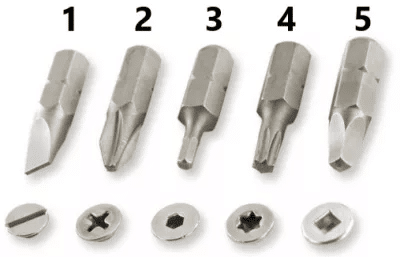
- Flat Head / Slotted / Straight wrench
- Phillips / Cross Head wrench
- Allen / Hex Head / Hex Key wrench
- Torx / Star Head wrench
- Robertson / Square-Head wrench
Question 3 of 7
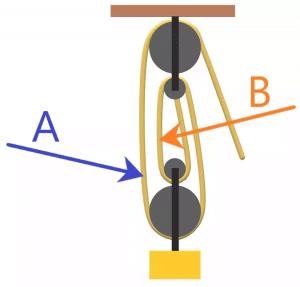
Which part of the string has a higher strain on it?
(If neither, mark C.)
- A
- B
- C
The correct answer is C.
The string attached to a pulley is considered to be massless and “non-stretchable.” Therefore, it has an equal distribution of tension forces acting on it. This is due to Newton’s Third Law of equal and opposite reaction, acting on every point of the string. Also, consider the force balance on a small section of the string. As each small section of the string is in equilibrium, the tension (T) acting on it on both sides will be the same as shown in the figure.
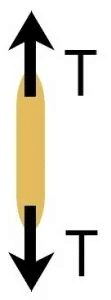
If you extend this argument over the whole length of the string, you can conclude that the tension will remain the same on every part of the string, which means that neither part of the string has a higher strain rate than the other.
Question 4 of 7
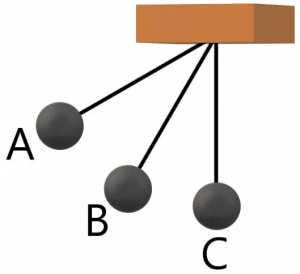
At which position will the pendulum normally travel the fastest?
- A.
- B.
- C.
The correct answer is C.
The pendulum given above is a simple pendulum, having a bob of mass “m”, hanging from the pivot with a string of length “l”. let us assume that the pendulum is released from the horizontal position, which is the highest the pendulum can go.
As we know the potential energy of an object is greatest at its highest position, the pendulum will have the most potential energy at the horizontal position A. However, the speed of the pendulum at this point will be zero, which shows that the kinetic energy will also be zero.
According to the law of conservation of energy, the total energy at all points should remain the same.
Now, potential and kinetic energies are given as:
Potential energy = mass (m) * gravitational acc.(g) * height
Kinetic energy = mass (m) * velocity(v)2 / 2 [mv2/2]
At position A, the pendulum bob will have a greater height than in positions B or C, so its potential energy will be greater, but since the total energy is the same, the kinetic energy will be less than that of the other positions. This means that it will travel slower.
As the bob moves downwards, the potential energy will keep converting to kinetic energy and at position C, all the potential energy will be converted to kinetic energy. Hence the bob will move the fastest at position C.
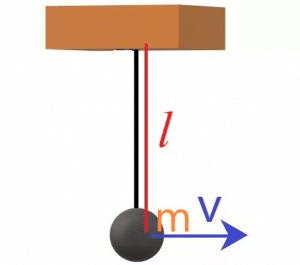
Question 5 of 7
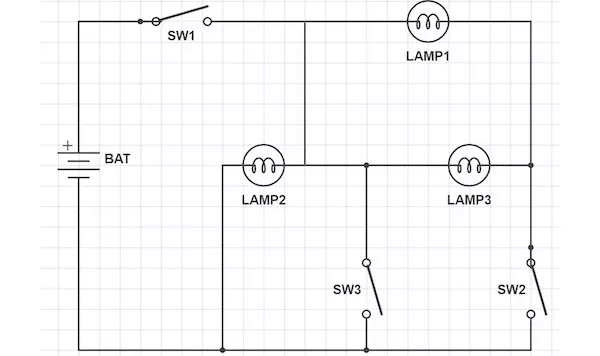
How many lamps will be lit if switch 1 is closed?
- 1
- 2
- 3
The correct answer is A – 1 lamp.
Current only flows between two points if there is a potential difference. In order to analyze the above circuit, define the nodes in the circuit. When switch 1 is closed, there are only three nodes—A, B, and C—in the circuit. In this case, lamps 1 and 2 are in the series; however, the potential difference across the series is zero since both end terminals are connected to node A. Therefore, lamps 1 and 3 will not light up. Lamp 2 is directly connected to the battery terminals A and C; therefore, lamp 2 will light up. This is why only one lamp will light up.
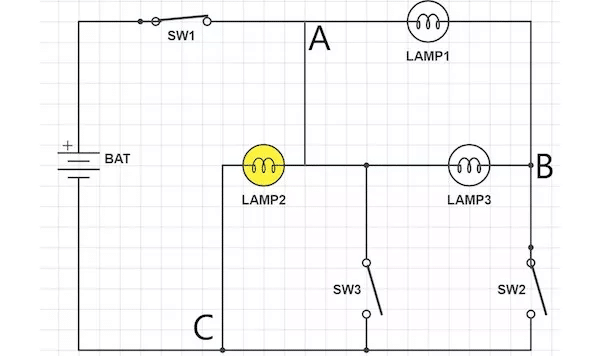
Question 6 of 7
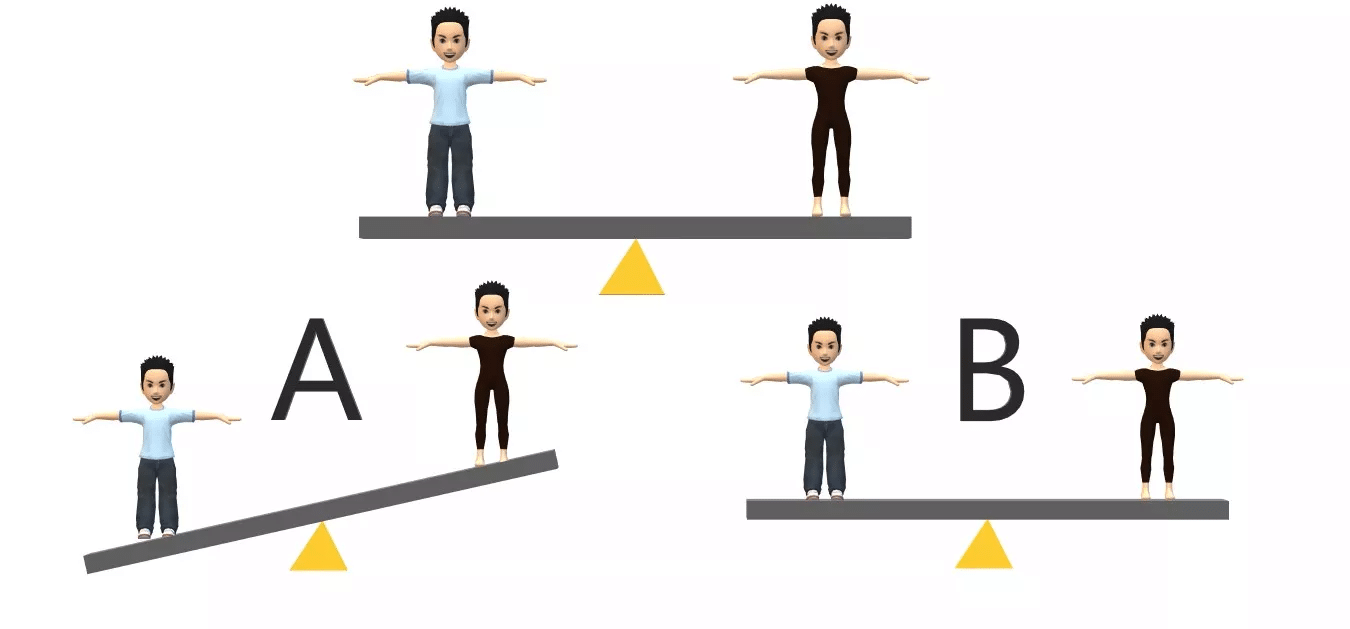
Two people are balanced on a seesaw as in the top part of the image. If the left person jumps up, which of the scenarios, A or B, is likely to happen upon landing on the seesaw?
(If equally likely, mark C.)
- A.
- B.
- C.
The correct answer is A.
This is a case of a class 1 lever, where the people on the sides are loads and the fulcrum is in the middle. When the person on the left jumps on a balanced seesaw, the weight of the person on the right unbalances the seesaw and it falls to the right. When the person on the left lands on the seesaw, an effort is exerted due to weight, which lifts the seesaw from the right. However, it does not stop right in the middle due to the extra energy from the jump and keeps lifting the person on the right, as can be seen in scenario A.
Question 7 of 7
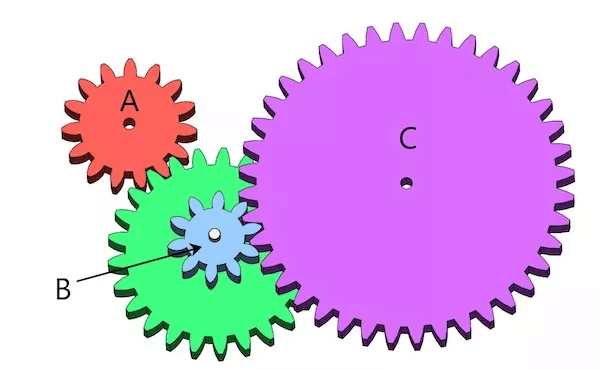
Which gear rotates fastest?
- A.
- B.
- C.
The correct answer is A.
The rotational velocities (ω) of directly meshed gears are inversely proportional to their number of teeth (N) as:
ω1/ω2 = N2/N1. This means that the greater the number of teeth is, the lower the speed is.
We have denoted the green gear as gear D. Now the number of teeth (N) of the gears is in the order: NB < NA < ND < NC.
Gear D directly meshes with gear A, so since gear A has fewer teeth than gear D, it rotates faster (ωA > ωD).
Since gear B and D are connected to the same shaft, they rotate at the same speed, i.e. ωB = ωD.
Gear B directly meshes with gear C, so since gear B has fewer teeth than gear C, it rotates faster (ωB > ωC).
Combining the conclusions above:
ωA > ωD = ωB > ωC
Gear A rotates the fastest and gear C rotates slowest.
Sample Flashcards
Well done!
You have completed the Sample Questions section.
The complete iPREP course includes full test simulations with detailed explanations and study guides.
‘…TESTS THAT ACTUALLY HELP’

In the first 30 minutes of use I have learned so much more than skipping along the internet looking for free content. Don’t waste you time, pay and get tests that actually help.
Richard Rodgers
January 28, 2020 at 7:49 PM
About the course
Welcome to iPrep’s Mechanical Aptitude Course.
This course will help you boost your skills and with it your confidence towards your upcoming mechanical aptitude test. The course will provide you with the following tools and benefits:
- You will become familiar with various types of mechanical aptitude questions.
- You will be given many mechanical aptitude simulation tests. Experiencing the test’s time pressure will ensure it will not come as a surprise on test day.
- You will be provided with a mechanical aptitude study guide, which will review the main topics to appear on real exams.
- You will find a great variety of helpful solving methods, theoretical explanations, and tips for the different types of questions. These are found in the detailed explanations that follow each question.
- This course also includes a comprehensive numerical skills review. If your test also includes a numerical section, you will be able to refresh your math skills with our comprehensive yet concise guides, which cover all the important aspects you may encounter on your test. Each section of the review is followed by test-level questions.
15
Learning hours
7
Practice tests
500
Questions
830
Videos
By the end of this course, you will be more knowledgeable and comfortable with mechanical and math aptitude questions, which intimidate many test-takers. Knowledge and familiarity with the test are the two most significant factors that can help you maximize your score and improve your chances of success.
Wishing you an enjoyable learning experience!
Skills you will learn
Mechanical Comprehension
Simple Machines
Everyday Mechanics
Curriculum
- Course Introduction
- Mechanical Comprehension Guide
- Test-Taking Tips
- Mechanical Aptitude Test Simulations
- Math Aptitude Test Review
- Tool Recognition
- Course Conclusion
Customer Testimonial

Extremely helpful and I feel more ready for my operator test. I like the fact that it has explanations and the correct answered unlike many others.
Raymundo Morgan
December 30, 2020 at 7:39 AM
Reviews

Josh W*****
April 10, 2025 at 12:32 AM
I am honestly extremely pleased with the content and learning material provided. The videos, imagery and written content is easy to review, concise and packed with information. Highly recommend!

Bridget R***
March 16, 2025 at 7:32 PM
This test prep has been extremely helpful in helping me to understand mechanical reasoning. I feel this gave me and will give others the advantage that they need to past the IBEW mechanical reasoning portion of the application test.

Donald A*****
March 16, 2025 at 6:01 PM
There was nothing i did not like about the course was very helpful it help to get me ready for job test. if someone is looking for help do this course

Joel D******
January 27, 2025 at 11:31 AM
Excellent test prep. I love comprehendible and easy it’s been. Although I wished it last forever instead of 30 days

Raven D***
December 2, 2024 at 2:16 AM
Me and my study buddy used this app to take an apprenticeship test and we both passed !!! I am so grateful for this app and will always refer back to it for any test i need to study for moving forward. Now to pass the interview process. FINGERS CROSSED !

Adebayo M*******
November 21, 2024 at 10:37 PM
" Wish I had come across Iprep couple of months back ... the presentation , syllabus , faculty and contents are top notch with excellent delivery. The targeted audience would find this extremely useful . I would recommend this resourceful material 1000 times . "

Kendrick C*******
November 5, 2024 at 4:50 AM
This course is comprehensive. There is a lot of information you so that you can understand how the mechanics actually work.

Jason J*******
November 2, 2024 at 1:05 PM
Clear and concise, has been a pleasure studying for this exam. I like the detailed explanations for answers in order to learn concepts. Definitely recommended.

Jeffrey F***
October 14, 2024 at 7:04 PM
I got this test prep because I found it difficult to find a good resource to study mechanical aptitude tests. iPrep is the best and most affordable resource I could find.

Marcus S****
October 11, 2024 at 4:10 AM
This course definitely helped me past my utility operator test! It provided a lot of good examples and practice questions that resembled the actual test. It was definitely worth the buy.























